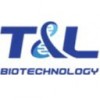Business Type:Others
Country/Region:China
Ddu Verified
HOT Rank


T&L Biotechnology
We are professional supplier of Recombinant human IL-7 protein,Recombinant Human IL-15 Protein,Recombinant Human IL-21 Protein,Humanized Anti-Human CD3 mAb,Humanized Anti-Human CD16 mAb,Humanized Anti
Business Type:Others
Country/Region:China
Ddu Verified
HOT Rank

Catalog Number: GMP-TL613
Product Name | |
Generic Name | Recombinant Human EGF Protein |
Synonym | URG, HOMG4 |
Product Information | |
Protein sequence | P01133-1 was expressed with a His-tag at the C-terminus. |
Expression Host | HEK293 cells |
QC Testing Purity | > 90 % as determined by SDS-PAGE |
Activity | Measured in a cell proliferation assay using Balb/c 3T3 cells. The ED50 for this effect is ≤3 ng/mL. |
Endotoxin Level | < 0.1EU per 1 μg of the protein by the LAL method. |
Molecular Mass | Predicts a molecular mass of 7.0 kD. |
Formulation | Lyophilized from sterile PBS, pH 7.4. Normally 6 % mannitol are added as protectants before lyophilization. |
Stability & Storage | 24 months at 2℃ to 8℃ in lyophilized state. 6 months at -20℃ under sterile conditions after reconstitution. 12 months at -80℃ under sterile conditions after reconstitution. Recommend to aliquot the protein into smaller quantities after reconstituting with water for injection, normal saline or PBS, and keep the diluted concentration above 100 μg/mL. Avoid repeated freeze-thaw cycles. |
Background | |
EGF is a growth factor that stimulates the growth of various epidermal and epithelial tissues in vivo and in vitro and of some fibroblasts in cell culture. It results in cellular proliferation, differentiation, and survival. EGF acts by binding with high affinity to epidermal growth factor receptor on the cell surface and stimulating the intrinsic protein-tyrosine kinase activity of the receptor. The tyrosine kinase activity, in turn, initiates a signal transduction cascade that results in a variety of biochemical changes within the cell - a rise in intracellular calcium levels, increased glycolysis and protein synthesis, and increases in the expression of certain genes including the gene for EGFR - that ultimately lead to DNA synthesis and cell proliferation. EGF is widely used as a mitogen in the culture of neural stem cells in vitro, and it can be used as an inducer to promote the differentiation of neural stem cells into neurons, astrocytes and oligodendrocytes. | |
References | |
1. Chen JX, et al. (2011) Involvement of c-Src/STAT3 signal in EGF induced proliferation of rat spermatogonial stem cells. Mol Cell Biochem.358(1-2):67-73. 2. Guo Y, et al. (2012) Correlations among ERCC1, XPB,UBE2I, EGF, TAL2 and ILF3 revealed by gene signatures of histological subtypes of patients with epithelial ovarian cancer. Oncol Rep. 27(1):286-92. 3. Kim S, et al. (2012) Smad7 acts as a negative regulator of the epidermal growth factor (EGF) signaling pathway in breast cancer cells. Cancer Lett. 314(2):147-54 . | |
Trial dosage: A customer can apply for up to five samples a year (the actual trial dosage is determined by telephone or email communication).
Scope of use: Samples are limited to testing and research purposes.
Cost: Free for samples, customer is responsible for shipping and handling charges, reference cost is $50 in the US, €60 in the EU, and $50 in other countries.
How to apply: You can apply by telephone or by email (the email application should specify the sample name, item number, contact person, telephone number, consignee address, etc.).